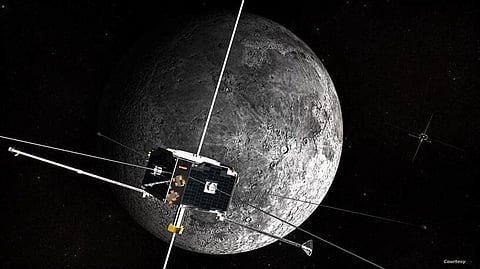
- Home
- न्यूजग्राम
- NewsGram USA
- India
- World
- Politics
- Entertainment
- Culture
- Lifestyle
- Economy
- Sports
- Sp. Coverage
- Misc.
- NewsGram Exclusive
- Jobs / Internships

Tuesday was the deadline for the commercial space industry to give NASA its proposals for an all-new 21st century lunar landing system as the United States strives to return to the moon within five years.
No one has been on the moon since December 14, 1972 when Apollo 17 took off from the lunar surface. It was the end of an era that began in July,1969 when the entire world held its breath to watch Neil Armstrong make that "giant leap for mankind."
NASA has celebrated the 50th anniversary of the first moon landing by not just looking back, but looking forward to Mars.
But the first stop on the way to Mars is a return trip to the moon.
Kristine Davis, a spacesuit engineer at the Johnson Space Center, wears a ground prototype of NASA's new Exploration Extravehicular Mobility Unit, during a demonstration of the suit, Oct. 15, 2019 at NASA Headquarters in Washington. (NASA/Joe Kowsky) VOA
Exploring the moon and living on it for extended periods in the late 2020s is a what NASA calls "practice ground" for learning to live on Mars in the 2030s.
"At the moon, we will learn how to live and operate on the surface of another celestial body where astronauts are just three days from home and prove the technologies we need before sending astronauts to Mars, which can take up to three years roundtrip," NASA spokeswoman Cheryl Warner tells VOA.
NASA called its 1960s moon mission Apollo. The 21st century moon program is dubbed Artemis — the Greek god's twin sister.
NASA needs to build an entirely new lunar landing system for Artemis — one that takes advantage of the technology that didn't exist in 1969. A replacement for the old Saturn rockets that launched the Apollo missions is in development. NASA unveiled a new spacesuit last month. The rovers that lumbered across the moon in the 1970s are no longer sufficient. Talks with Canada, Japan, and Australia are already under way on how to build a uniform system because, NASA says, Artemis will include international and commercial partners.
The same questions people were asking in 1969 are still being thrown about today — why go to the moon? Why spend the billions that can be invested on Earth to battle such immediate problems as global warming and poverty.
Art Harman, a former congressional aide and president of the Coalition to Save Manned Space Exploration, can tell you in one word: water — discovered about 15 years ago in craters at the South and North Poles.
"There's enough water ice it appears to support humanity for maybe a million years. You've got water to drink, you've got oxygen to breathe, you've got hydrogen and oxygen to make rocket fuel and you've got all the minerals that are in the soil on the moon."
The moon could also provide a major tool to fight global warming. Harman says there are massive deposits of helium-3 — a gas that is rare on Earth. Helium-3 can be used in clean, safe, and non-radioactive nuclear fusion power reactors and greatly ease the dependence on fossil fuels.
Dustin Gohmert, Orion Crew Survival Systems Project Manager at the Johnson Space Center, wears a prototype of the NASA Orion Crew Survival System suit, Oct. 15, 2019. VOA
Harman says China has already announced its intention to bring back helium- 3. A Chinese lander touched down on the dark side of the moon in January and Beijing has said it intends to send Chinese astronauts by the end of the 2020s.
Harman says the new space race between China and the United States is much more serious than the 1960s, when the United States and Soviet Union were more interested in national pride and bragging rights.
"They talk about the moon in the same terms they use as the South China Sea so they see it as something to seize and their property," Harman says.
"They have designs for a massive military radar that would be on the moon that would map almost in real time every military asset in the world and so they're uses are not peaceful."
Beijing has said its interest in space is purely economic.
NASA's Cheryl Warner says as of now, it wants Americans, especially students, to get as excited about returning to space with the same intrigue and optimism of the 1960s.
"We are committed to achieving our exploration goals and to reigniting America's passion or space exploration, innovation, and discovery. Just like the Apollo program had a profound cultural impact, driving greater interest in STEM (science technology engineering and math). We anticipate our Artemis program will do the same." (VOA)
